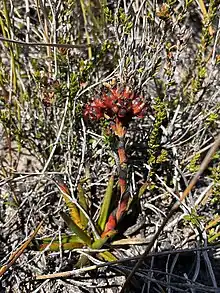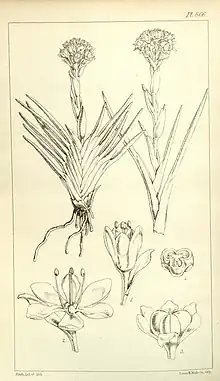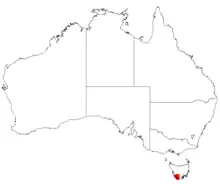Haemodorum distichophyllum
Haemodorum distichophyllum, also known as the Moorland Bloodroot, is a plant in the Haemodoraceae (blood root) family, native to Tasmania.[2] It was first described by William Jackson Hooker in 1852, from a specimen collected at Macquarie Harbour by Ronald Gunn in 1846.[3][1]
| Haemodorum distichophyllum | |
|---|---|
 | |
| Growing in Southwest National Park, Tasmania | |
 | |
| Plate 866, Icones Plantarum.[1] | |
| Scientific classification | |
| Kingdom: | Plantae |
| Clade: | Tracheophytes |
| Clade: | Angiosperms |
| Clade: | Monocots |
| Clade: | Commelinids |
| Order: | Commelinales |
| Family: | Haemodoraceae |
| Genus: | Haemodorum |
| Species: | H. distichophyllum |
| Binomial name | |
| Haemodorum distichophyllum | |
 | |
| Occurrence data from the Australasian Virtual Herbarium | |
It is a very low growing plant, growing to heights of 3 cm to 9.5 cm.[4] It is found in heath and button grass plains of western Tasmania at various altitudes.[4]
References
- Hooker, W.J. (1852). Icones Plantarum. Vol. 9. pp. t. 866.
- "Haemodorum distichophyllum Hook. | Plants of the World Online | Kew Science". Plants of the World Online. Retrieved 24 January 2023.
- "Haemodorum distichophyllum". Australian Plant Name Index (APNI). Australian Government. Retrieved 23 January 2023.
- T.D.Macfarlane. "Haemodorum distichophyllum". Flora of Australia. Australian Biological Resources Study, Department of Climate Change, the Environment and Water: Canberra. Retrieved 24 January 2023.
External links
This article is issued from Wikipedia. The text is licensed under Creative Commons - Attribution - Sharealike. Additional terms may apply for the media files.